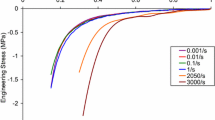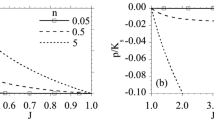Abstract
Elastomeric foams are widely used in different types of applications where different material properties are of interest in each application. All of these properties are governed by the microstructure and the properties of the material matrix. Studying the evolution of the microstructure experimentally is extremely challenging. Thus, here we use direct numerical simulations to gain an insight into the changes that happen from the creation of the gas bubbles in the liquid state, until the solidification into a cellular morphology. Furthermore, the resulting microstructure is then used directly in simulations of solid mechanical testing to determine the mechanical properties of the foam. The matrix fluid is assumed to be Newtonian and incompressible. A linear elastic isotropic material model for the solidified polymer was used to obtain the solid foam properties. The foam was described by a representative volume element (RVE), where a small number of bubbles was randomly distributed. Using this approach, the RVE can describe the bulk behavior of the foam, while remaining computationally tractable. Microstructures with volumes fraction of over 90% (2D) and 45% (3D) are accurately captured. In addition, the influence that the bubble growth rate and the initial bubble distribution of the fluid simulations have on the solid foam properties was studied.





















Similar content being viewed by others
References
Amon M, Denson CD (1986) A study of the dynamics of foam growth - simplified analysis and experimental results for bulk density in structural foam molding. Polym Eng Sci 26(3):255–267. https://doi.org/10.1002/pen.760260311
Amon M, Denson DC (1984) A study of the dynamics of foam growth - analysis of the growth of closely spaced spherical bubbles. Polym Eng Sci 24(13):1026–1034. https://doi.org/10.1002/pen.760241306
Arefmanesh A, Advani SG (1991) Diffusion-induced growth of a gas bubble in a viscoelastic fluid. Rheol Acta 30(3):274–283. https://doi.org/10.1007/BF00366641
Ashby M (2006) The properties of foams and lattices. Philos Trans R Soc A Math Phys Eng Sci 364(1838):15–30. https://doi.org/10.1098/rsta.2005.1678.
Brackbill JU, Kothe DB, Zemach C (1992) A continuum method for modeling surface tension. J Comput Phys 100(2):335–354. https://doi.org/10.1016/0021-9991(92)90240-Y, fld.1
Chen C, Lu TJ, Fleck NA (1999) Effect of imperfections on the yielding of two-dimensional foams. J Mech Phys Solids 47(11):2235–2272. https://doi.org/10.1016/S0022-5096(99)00030-7
Everitt SL, Harlen OG, Wilson HJ (2006a) Bubble growth in a two-dimensional viscoelastic foam. J Non-Newtonian Fluid Mech 137(1–3):46–59. https://doi.org/10.1016/j.jnnfm.2006.03.004
Everitt SL, Harlen OG, Wilson HJ (2006b) Competition and interaction of polydisperse bubbles in polymer foams. J Non-Newtonian Fluid Mech 137(1–3):60–71. https://doi.org/10.1016/j.jnnfm.2006.03.005
Feng JJ, Bertelo CA (2004) Prediction of bubble growth and size distribution in polymer foaming based on a new heterogeneous nucleation model. Journal of Rheology 48(2):439–462. https://doi.org/10.1122/1.1645518.
Ferkl P, Karimi M, Marchisio DL, Kosek J (2016) Multi-scale modelling of expanding polyurethane foams: coupling macro- and bubble-scales. Chem Eng Sci 148:55–64. https://doi.org/10.1016/j.ces.2016.03.040
Gaitanaros S, Kyriakides S, Kraynik AM (2012) On the crushing response of random open-cell foams. Int J Solids Struct 49(19–20):2733–2743. https://doi.org/10.1016/j.ijsolstr.2012.03.003
Geuzaine C, Remacle JF (2009) Gmsh: a 3-D finite element mesh generator with built-in pre- and post-processing facilities. International Journal for Numerical Methods in Engineering (79)1309–1331. https://doi.org/10.1002/nme.2579
Gibson LJ, Ashby MF (1997) Cellular solids, Cambridge University Press, Cambridge. https://doi.org/10.1017/CBO9781139878326. http://ebooks.cambridge.org/ref/id/CBO9781139878326. arXiv:1011.1669v3
Gibson LJ, Ashby MF, Karam GN, Wegst U, Shercliff HR (1995) The mechanical properties of natural materials. II: Microstructures for mechanical efficiency. Proc R Soc Lond A 450(1938):141–162. https://doi.org/10.1098/rspa.1995.0076
HSL (2013) A collection of Fortran codes for large scale scientific computation
Hu HH, Patankar NA, Zhu MY (2001) Direct numerical simulations of fluid-solid systems using the arbitrary Lagrangian-Eulerian technique. J Comput Phys 169(2):427–462. https://doi.org/10.1006/jcph.2000.6592
Jaensson NO, Hulsen MA, Anderson PD (2015) Stokes-Cahn-Hilliard formulations and simulations of two-phase flows with suspended rigid particles. Comput Fluids 111:1–17. https://doi.org/10.1016/j.compfluid.2014.12.023
Jaensson NO, Mitrias C, Hulsen MA, Anderson PD (2018) Shear-induced migration of rigid particles near an interface between a newtonian and a viscoelastic fluid. Langmuir 34 (4):1795–1806. https://doi.org/10.1021/acs.langmuir.7b03482
Jang WY, Kyriakides S (2009) On the crushing of aluminum open-cell foams: Part II analysis. Int J Solids Struct 46(3–4):635–650. https://doi.org/10.1016/j.ijsolstr.2008.10.016
Jang WY, Kraynik AM, Kyriakides S (2008) On the microstructure of open-cell foams and its effect on elastic properties. Int J Solids Struct 45(7–8):1845–1875. https://doi.org/10.1016/j.ijsolstr.2007.10.008
Jang WY, Kyriakides S, Kraynik AM (2010) On the compressive strength of open-cell metal foams with Kelvin and random cell structures. Int J Solids Struct 47(21):2872–2883. https://doi.org/10.1016/j.ijsolstr.2010.06.014
Karimi M, Marchisio DL (2015) A baseline model for the simulation of polyurethane foams via the population balance equation. Macromol Theory Simul 24(4):291–300. https://doi.org/10.1002/mats.201500014
Krop S, Meijer HE, Van Breemen LC (2016) Global and local large-deformation response of sub-micron, soft- and hard-particle filled polycarbonate. J Mech Phys Solids 87:51–64. https://doi.org/10.1016/j.jmps.2015.11.005
MARC/MENTAT (2014) http://www.mscsoftware.com/product/marc
Mitrias C, Jaensson NO, Hulsen MA, Anderson PD (2017) Direct numerical simulation of a bubble suspension in small amplitude oscillatory shear flow. Rheol Acta 56(6):555–565. https://doi.org/10.1007/s00397-017-1009-0
Ramesh NS, Rasmussen DH, Campbell GA (1991) Numerical and experimental studies of bubble growth during the microcellular foaming process. Polym Eng Sci 31(23):1657–1664. https://doi.org/10.1002/pen.760312305
Saad Y (2001) SPARSKIT: A basic tool kit for sparse matrix computations. Tech. rep., NASA Ames Research Center
Villone MM, Hulsen MA, Anderson PD, Maffettone PL (2014) Simulations of deformable systems in fluids under shear flow using an arbitrary Lagrangian Eulerian technique. Comput Fluids 90:88–100. https://doi.org/10.1016/j.compfluid.2013.11.016
Yserentant H (1991) Two multi-level methods for nonuniformly refined grids. In: Spedicato E (ed) Computer algorithms for solving linear algebraic equations. https://doi.org/10.1007/978-3-642-76717-3. Springer, Berlin, pp 161–167
Yue P, Feng JJ, Bertelo CA, Hu HH (2007) An arbitrary Lagrangian-Eulerian method for simulating bubble growth in polymer foaming. J Comput Phys 226(2):2229–2249. https://doi.org/10.1016/j.jcp.2007.07.007
Funding
The research leading to these results has received funding from the European Commission under the grant agreement number 604271 (Project acronym: MoDeNa; call identifier: FP7-NMP-2013-SMALL-7).
Author information
Authors and Affiliations
Corresponding author
Additional information
Publisher’s note
Springer Nature remains neutral with regard to jurisdictional claims in published maps and institutional affiliations.
Appendix: Refining in 3D
Appendix: Refining in 3D
Mesh refinement is needed to accurately describe the fluid dynamics in the thin layer between bubbles. However, the refinement of the mesh in three dimensions is more cumbersome than in the two-dimensional case, since now the mesh consist of quadratic triangles. Triangles require two different types of refinement, regular and irregular refinement (Yserentant 1991). Regular refinement splits one triangular surface element into four new ones and irregular refinement splits one triangular surface element into two new ones (see, Fig. 22a). Elements generated during irregular refinement are called green elements. An element before refinement is called the parent element. During refinement, new smaller elements are created, which are called siblings. Regular refined elements will therefore have four siblings, while irregular refined elements will have only two. Every element has its own refinement level and by regular refinement the level is increased by one.
a Regular refinement (top) and irregular refinement (bottom) of an element. The blue circles are the location of the nodes. b Regular refinement of marked element (M). The neighboring elements are not refined and hanging nodes are created (red nodes). To avoid hanging nodes, the neighboring elements are irregularly refined
While refining a single element, unwanted hanging nodes would be generated on its sides, if the neighboring elements were not refined as well (see, Fig. 22b). When an element is marked for regular refinement (M), its neighboring elements are marked to be irregularly refined (G) in order to get rid of hanging nodes (see, Fig. 23a). When a green element is marked for refinement (Fig. 23b), the irregular refinement is first removed and the parent element is regularly refined, as in Fig. 23c.
a Three elements are marked for regular refinement(M), as a result 5 neighboring elements are marked for irregular refinement(G), to withhold the creation of hanging nodes. b Green elements marked for refinement. c Regular refinement of green elements. d On the left, two neighboring elements of different refinement level are marked, which results in an element that is marked for both regular refinement and for irregular refinement. This cannot be done, however to solve this; refinement is done level by level. The marked elements on the right show that no double green elements can be created. e The final obtained structure
The elements in the mesh are refined level by level, starting with elements with the lowest refinement level, to get rid of hanging node that are generated when two neighboring elements are refined and are of different refinement level (see, Fig. 23d). In Fig. 23, some basic cases of mesh refinement previously mentioned are shown. In every next figure, the marked elements in the previous figure are refined.
Rights and permissions
About this article
Cite this article
Mitrias, C., Egelmeers, T. . ., Jaensson, N. . et al. Simulation of bubble growth during the foaming process and mechanics of the solid foam. Rheol Acta 58, 131–144 (2019). https://doi.org/10.1007/s00397-018-01123-x
Received:
Revised:
Accepted:
Published:
Issue Date:
DOI: https://doi.org/10.1007/s00397-018-01123-x






